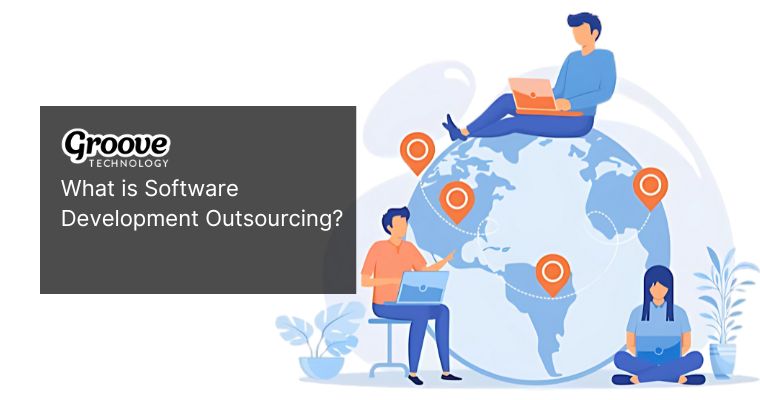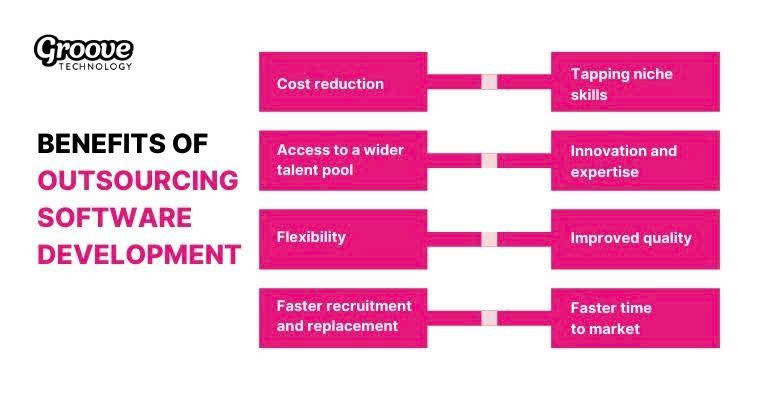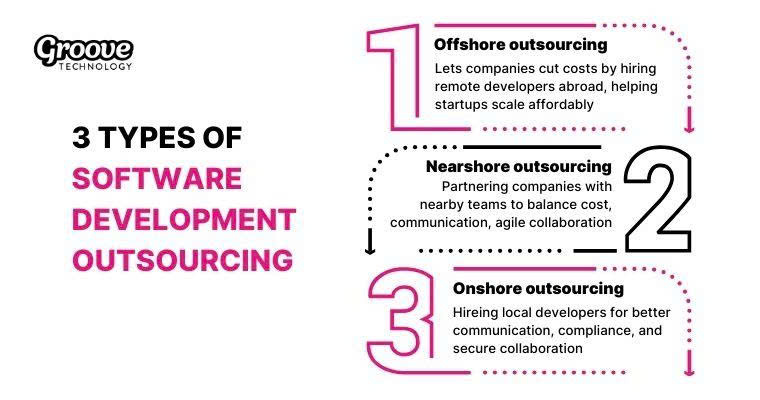What is Outsourcing Software Development? A Comprehensive Guide in 2025
Software development outsourcing refers to the practice of hiring an external team or third-party provider to develop and manage software projects, rather than relying solely on in-house resources. This service allows businesses to focus on core operations while leveraging specialized expertise. With its numerous advantages, the global IT outsourcing market is booming, expected to grow from $617.69 billion in 2024 to over $800 billion by 2029.
Recognizing the strategic value of outsourcing, Groove Technology offers a comprehensive guide to outsourcing software development, from understanding different models to selecting the right partner. Read on to discover how outsourcing can boost efficiency, reduce costs, and accelerate your business success.

1. What is Software Development Outsourcing?
Software development outsourcing refers to the practice of partnering with an external team (often located in another country) to handle software engineering tasks instead of relying solely on internal resources. This approach typically involves delegating responsibilities such as application development, system maintenance, performance optimization, and quality assurance to specialized professionals.
Today, outsourcing goes far beyond traditional cost-saving motives. Businesses increasingly turn to it as a strategic way to access world-class engineering talent, cutting-edge technologies, and niche expertise that may not be readily available in their local market. At the same time, companies can avoid the complexities of long-term hiring, onboarding, and operational overhead.
The global demand for outsourced software development continues to rise. According to Statista, the market is projected to expand from $430 billion in 2023 to nearly $898 billion by 2031, achieving a CAGR of 5 – 7.5%. This significant growth underscores how organizations are prioritizing flexible, scalable, and expert-driven solutions to accelerate their product development cycles, exactly what software development outsourcing is designed to deliver.

2. Services in Outsourced Development Packages
Outsourcing software development provides end-to-end technology solutions that streamline operations, enhance scalability, and drive digital transformation. Software application development outsourcing include:
- Full Stack Development: Specializing in both frontend and backend development, offering expertise in technologies like Microsoft Stack/.NET, Python, Node.js for backend, and React.js, Angular.js for frontend.
- Web Application Development: Customizing web applications to meet specific business needs, simplifying workflows with unique and niche applications that enhance efficiency.
- Mobile App Development (React Native App): Developing native apps for iOS and Android platforms, streamlining the development process using React Native to ensure faster deployment and performance.
- IoT Development: Creating interconnected applications for web or mobile, utilizing smart devices and data analytics to provide seamless, user-friendly experiences.
- DevOps Services: Offering end-to-end DevOps solutions, including development, automation, plugin integration, and API development, helping businesses scale quickly and improve operational efficiency.
- UI/UX Design: Crafting intuitive user interfaces and enhancing user experiences through impactful design, ensuring seamless interaction with digital platforms.
- Business Analysis: Collaborating closely with stakeholders to analyze business requirements, translating them into functional specifications that meet strategic objectives.
- Project Management: Expertly managing project timelines and budgets, ensuring the smooth execution and delivery of projects on schedule and within scope.
3. 3 Types of Software Development Outsourcing
Software development collaborations exist in three distinct models: offshore, nearshore, and onshore outsourcing. Each approach offers unique advantages depending on business priorities, project complexity, and budget constraints.
- Offshore outsourcing involves working with developers located in distant countries, often with significant time zone differences. This model is typically chosen to cut expenses by leveraging lower labor costs in developing economies. It’s an attracti
 ve option for startups or mid-sized companies aiming to build a product from scratch or scale rapidly while staying within budget.
ve option for startups or mid-sized companies aiming to build a product from scratch or scale rapidly while staying within budget. - Nearshore outsourcing connects businesses with development teams in neighboring or nearby countries, usually within 1 – 4 time zones. This approach offers a practical balance between cost-efficiency and communication convenience. It allows for easier real-time collaboration and faster response times, making it ideal for mid-to-large companies that want to remain agile and responsive during development without disrupting internal workflows.
- Onshore outsourcing refers to hiring development resources within the same country. Although it generally comes with higher costs, this model ensures seamless communication, cultural alignment, and compliance with domestic regulations. Onshore solutions are often preferred by organizations in highly regulated sectors such as finance, healthcare, or government, where data security, legal compliance, and real-time collaboration are top priorities.
4. 2 Engagement Models of Outsourcing Software Development
There are 2 primary software development outsourcing models: Staff Augmentation model and the Dedicated Teams model. These models differ in terms of control, flexibility, and cost structure, allowing businesses to choose the right approach based on their project needs.
Staff Augmentation
Software development staff augmentation involves hiring external professionals to complement in-house teams. This type of outsource software development services is typically used to fill specific skill gaps or temporarily boost team capacity. It offers businesses high control over their projects, as augmented staff work directly with the company’s existing team, following internal processes and reporting to management.
For example, a company may hire a specialized AI developer to accelerate a project phase without committing to a long-term hire.

Dedicated Team Model
The dedicated software development team model involves outsourcing a full team to work solely on a client's project over a set period. This team operates independently but works closely aligned with the client's objectives and workflows. It's flexible in staffing and project management, making it ideal for long-term projects that may evolve in scope.
For example, a company may outsource the development of a CRM application to a dedicated team, entrusting them to handle every requirement from inception to completion.
5. Which Business Commonly Uses Outsourced Development Services?
Outsourced software development is widely adopted across industries, offering flexibility, speed, and specialized expertise. Here are the key types of businesses that frequently leverage it:
- Startups & Small Businesses: With limited resources, they outsource to quickly build MVPs and scale operations, especially in tech-driven sectors like fintech or e-commerce.
- Medium-Sized Enterprises: Often in growth mode, they outsource to supplement in-house teams and accelerate digital projects.
- Large Corporations: Despite having IT departments, they outsource for innovation, scalability, and to stay competitive.
- Non-Tech Companies: Businesses undergoing digital transformation outsource to modernize operations without building full tech teams.
- E-commerce Companies: From small shops to large platforms, they outsource for scalable, feature-rich systems like payment gateways or AR features.
- Healthcare Providers: Hospitals and healthtech firms outsource HIPAA-compliant solutions such as telemedicine platforms and patient data systems.
- Financial Institutions: Banks and insurers outsource secure fintech solutions like mobile banking apps and fraud detection systems.
- Educational Institutions: Schools and e-learning platforms outsource LMSs, educational apps, and virtual labs.
- Government Agencies: Outsource citizen services, internal systems, and smart city applications to improve efficiency and public engagement.
- Media & Entertainment: Streaming and gaming companies outsource to develop interactive platforms, content systems, and algorithms.

Outsourced software development is widely adopted across industries, offering flexibility, speed, and specialized expertise
6. Benefits Of Outsourcing Software Development
There are eight key advantages to outsourcing software development that enable companies to enhance efficiency, reduce costs, and improve overall project outcomes.
- Cost reduction: Outsourcing helps businesses lower costs for recruiting, development, and management. Companies avoid expenses like employee benefits, retirement contributions, and other overheads associated with in-house teams.
- Access to a wider talent pool: Outsourcing software development service connects companies with a diverse range of skilled professionals, providing expertise that may be unavailable locally and matching specific project needs.
- Flexibility: Outsourcing allows companies to focus on their core operations while external teams handle non-essential tasks. This model also enables easy scaling of development resources to accommodate fluctuating project demands.
- Faster recruitment and replacement: Compared to in-house hiring, outsourcing simplifies the process of sourcing and replacing staff, bypassing the complexities of severance packages and long-term contracts.
- Tapping niche skills: Outsourcing provides immediate access to specialized expertise (e.g., machine learning, data engineering, cloud migration) that would otherwise require significant investment in upskilling internal teams.
- Innovation and expertise: Outsourcing firms bring cutting-edge technologies and expert knowledge, fostering innovation that boosts productivity and cost-efficiency.
- Improved quality: Outsourcing companies often have established quality assurance processes and offer fresh perspectives, which enhance product quality and help reduce technical debt.
- Faster time to market: With access to specialized expertise and the ability to work across time zones, outsourcing accelerates development timelines, enabling companies to deliver products more quickly and stay competitive.

7. Challenges Of Software Development Outsourcing
While software development outsourcing offers numerous benefits, it also comes with a few outsourcing risks. These five disadvantages can impact project outcomes and require careful management.
- Language barrier: Effective communication is crucial in software development. Language differences can create misunderstandings, making it harder for teams to collaborate and outsource software developers to deliver optimal solutions.
- Changing developers mid-project: Without clear procedures for project documentation, losing team members during a project can lead to delays and lower-quality work.
- Loss of control over project outcomes: Outsourcing the entire project to an external team reduces the company’s control over quality, adherence to requirements, and industry best practices.
- Scope misunderstanding leading to budget issues: Failing to define project scope, requirements, and timelines clearly can lead to uncontrolled scope creep, resulting in budget overruns and unmet expectations.
- Security risks: Sharing sensitive information with outsourcing vendors can expose a company to potential data breaches, intellectual property theft, and non-compliance with regulations like GDPR or HIPAA. Thorough vetting of partners is necessary to mitigate these risks.

8. Top Regions for Software Development Outsourcing in 2025
In 2025, the landscape of software development outsourcing is more dynamic than ever. This guide explores the best countries to outsource software development that are setting new standards in the industry, helping companies stay competitive while optimizing development costs.
| Region | Key Features |
| Vietnam | Rapidly emerging tech hotspot valued at $694.8 million (2024), projected 12.23% annual growth to $1.23 billion by 2029 |
| Poland | European IT powerhouse with $9.45 billion total market size (2024), outsourcing services generating $3.49 billion |
| Ukraine | Established offshore programming destination valued at $1.09 billion (2024), expected to reach $1.79 billion by 2029 |
| Croatia | Boutique market worth $304.7 million with exceptional English fluency, ranked 11th on EF EPI among 113 nations |
| Czech Republic | Ascending European hub with $2.28 billion outsourcing market and approximately 130,000 developers |
| Romania | Substantial talent pool exceeding 200,000 developers, fourth largest in Europe |
| India | Premier global destination with 5.2 million programmers, market valued at $11.04 billion (2024), known for competitive pricing |
| China | Unmatched concentration of 7+ million developers, market valued at $29.03 billion (2024), projected to reach $45.31 billion by 2029 |
| Argentina | Flourishing South American hub hosting 11 of 34 Latin American unicorns with 115,000+ skilled developers |
| Brazil | Dominant Latin American leader with 500,000 developers and market valued at $6.63 billion (2024) |
9. A Step-to-step Guide to Outsource Software Development Service
Outsourcing software development can significantly enhance your company's scalability, access to global talent, and cost efficiency, but only when done strategically. Below is a concise step-by-step guide to help you navigate the outsourcing process effectively and minimize risks while maximizing value:
- Step 1: Define goals and requirements: The business should clarify its objectives, project scope, technical needs, budget, and timeline. Clear documentation makes it easier to select the right vendor and avoid mid-project changes.
- Step 2: Set a realistic budget: Budgets should reflect the project’s complexity and duration. Extremely low bids often compromise quality, so long-term value should remain the priority.
- Step 3: Choose the right model: Depending on the objectives, the organization can adopt staff augmentation, a dedicated team, or full-project outsourcing. The internal team should consider time zones, communication styles, and cost levels in each region.
- Step 4: Find a reliable partner: Potential partners should be shortlisted based on experience, portfolio strength, client reviews, and pricing transparency. Case studies and verified feedback help validate capabilities.
- Step 5: Set up agreements and tools: The contract must clearly define IP ownership, NDAs, milestones, and payment terms. Both teams should align on communication channels and project management tools such as Slack, Zoom, Jira, or Trello.
- Step 6: Monitor and give feedback: Regular check-ins and open communication ensure alignment throughout the project. Clear, actionable feedback helps keep development on track.
- Step 7: Ensure QA and handoff: Thorough QA, including automated testing and UAT, should be conducted before final delivery. At completion, the business must receive all source code and documentation and hold a retrospective to improve future processes.
10. How Much Does Software Development Outsourcing Services Cost?
The outsource software development cost varies based on four main factors, including geographic location, developer skill level, project complexity, and the type of engagement model used. Besides, costs can vary significantly depending on the location of the development team and the expertise required for the project.
Here is a table of estimated hourly rates by region:
| Region | Hourly Rate Range ($) | Popular Countries |
| North America | $71 – $95 | USA, Canada |
| Central Europe | $42 – $74 | Czech Republic, Hungary, Poland, Slovakia, Switzerland |
| Eastern Europe | $27 – $51 | Belarus, Bulgaria, Romania, Ukraine |
| South Asia | $22 – $44 | India, Pakistan, Bangladesh |
| Southeast Asia | $24 – $35 | Indonesia, Philippines, Vietnam, Malaysia, Singapore |
| Latin America | $35 – $60 | Argentina, Mexico, Brazil, Colombia, Peru, Chile |

FAQs
Is outsourced software development suitable for startups?
Yes, outsourcing software development for startups can be particularly beneficial. It allows access to experienced developers without the long-term commitment and overhead costs of hiring full-time employees, making it an attractive option to outsource your software development. Startups can leverage outsourcing to quickly build MVPs (Minimum Viable Products), test market fit, and scale their development efforts as needed.
How do software outsourcing and in-house development compare?
Outsourcing offers global talent, cost flexibility, and rapid scalability but requires structured remote management and legal safeguards for intellectual property. In-house development provides direct control, seamless collaboration, and alignment with company culture but incurs higher fixed costs and slower scalability. While outsourcing speeds up time-to-market with dedicated resources, in-house teams may face delays due to competing priorities.
How many companies outsource software development?
A significant majority of businesses outsource their IT functions, with 76% of companies engaging in software development outsourcing. This trend is expected to continue, with outsourcing revenue projected to grow at a 7.54% CAGR until 2027.
Conclusion
Outsourced software development offers a powerful strategy for businesses looking to innovate, scale, and stay competitive in the digital age. Companies can accelerate their growth and digital transformation efforts by leveraging global talent, reducing costs, and focusing on core business activities.
However, success in outsourcing software development requires careful planning, clear communication, and a strategic approach to partner selection and project management. By understanding the guide to software development outsourcing, businesses can harness the full potential of outsourced software development. Connect with Groove Technology to harness global expertise and elevate your business capabilities.
Related Articles:
- Staff Augmentation vs Software Outsourcing: Which Model Is Right for You?
- How to Choose a Software Outsourcing Company? Key Tips and Criteria
- Best Java Development Outsourcing Companies in 2024: Top 11 Partners




 ve option for startups or mid-sized companies aiming to build a product from scratch or scale rapidly while staying within budget.
ve option for startups or mid-sized companies aiming to build a product from scratch or scale rapidly while staying within budget. 
